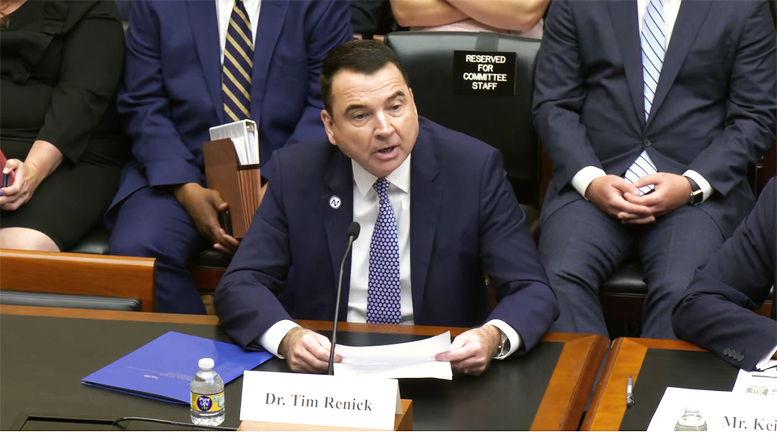A House hearing on Wednesday explored innovations in higher education to help students succeed, including programs focused on community colleges, such as dual enrollment and the Accelerated Study in Associate Programs.
Rep. Burgess Owens (R-Utah), chair of the House Education and the Workforce’s Subcommittee on Higher Education and Workforce Development, opened the hearing by noting there are good ideas to revamp higher education — competency-based education, three-year-degree programs and online education, among them — but some of those efforts are hampered by the legislative framework under the Higher Education Act (HEA), which hasn’t been fully updated since 2008.
“This traditional framework is at odds with the modern university experience and student,” Owens said. “Over 30% of today’s students are nontraditional, meaning they could be 25 years or older, part-time enrollees, full-time workers or in other unique situations.”
Rep. Wilson (D-Florida) cautioned not to focus too much on innovation at the expense of access and student support.
“Sacrificing equal access and opportunity for innovation is a disservice to students,” said Wilson, who earlier cited the declining value of Pell grants in the face of rising college costs and less state investment in higher education.
Lanae Erickson, senior vice president for social policy, education and politics at Third Way, echoed the importance of being careful with new programs. For example, there’s growing interest in Congress to expand Pell Grant eligibility to quality, short-term workforce development programs. But lawmakers would need to include guardrails to protect students from low-grade programs that could leave them worse off, she said.
Equitable dual enrollment
Wilson noted the potential of dual enrollment programs to help encourage students to continue to college while reducing their college costs by earning postsecondary credits while in high school. However, dual enrollment needs to be more equitable, Wilson said, noting that the programs are more accessible to white, affluent students than students of color.
“Proper investment and recruitment and retention of minority students could drastically improve dual enrollment’s student body diversity and ensure this innovative program reaches all students,” she said.
Deeper dive into what works
Several of the programs highlighted by witnesses at the hearing are already well-known for their successes, including data-informed and student-centered efforts at Georgia State University (GSU) and the Accelerated Study in Associate Programs (ASAP) program, which was created by the City University of New York system and piloted by a handful of other states.
A new longitudinal study by GSU shows how micro-grants have effectively kept students enrolled. Tim Renick, executive director of the National Institute for Student Success at GSU, noted that students who stop out, even for a semester, because of financial reasons, see their chances of graduation drop by about 50 percentage points. The university has been focused on providing small grants — it has issued about 19,000 grants, averaging about $900 each — specifically to help students with financial need to keep them enrolled. As a result, 80% of the grant recipients have graduated, he said.
“What it indicates is we need to be a lot more flexible and data-oriented in the way we award aid,” Renick said.
Ties to community college
Rep. Virginia Foxx (R-North Carolina), who chairs the House Education and the Workforce Committee and is a former community college president, asked about lessons learned from Perimeter Community College’s merging into GSU in 2016. Renick said there are more similarities than differences between students from both institutions. For example, all students need clear pathways, guidance and assistance to get back on track if they veer off, he said.
While GSU has improved its graduation rate by 70% over a decade, it has helped Perimeter triple its graduation rate over five years, Renick said.
“These students who are often under-resourced are even more needful of the kind of pro-active supports and the use of data and the use of technology to serve them,” he said, noting that many more community college students than four-year students are working, supporting families and crunched for time.
Act on data
Renick said his institute, which works with about 40 schools, is focused on helping colleges use data to make decisions. Institutions already collect plenty of data on their students, but the challenge is to act on them, he said.
“The prevailing problem is not a lack of data; it’s a lack of operationalizing the data that the campuses already have,” Renick said. “In some cases, they are overwhelmed with data that is being produced by systems and platforms on a day-to-day basis. What the institute is trying to help these campuses recognize is you can produce high-level data, but if it’s not in the hands of people making decisions in a timely fashion, it’s not going to be beneficial to the students or the institution.”
Renick also cautioned colleges against automatically cutting support staff — advisors, counselors, financial aid help and others — when eyeing necessary budget cuts because it would be like “shooting yourself in the foot.”
“These are the very people on campus who will help generate the tuition and revenues that will sustain these institutions,” he said.

